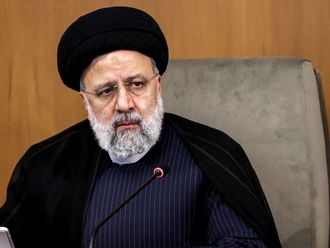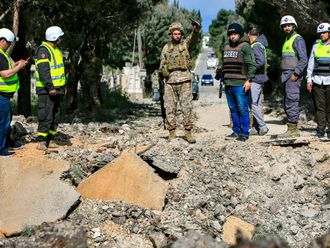Beirut: The army has shrunk by nearly half since Syria’s conflict erupted in 2011 but experts say the remaining military force is now both more flexible and capable.
It has transformed itself from a traditional military built on the former Soviet model into an effective counterinsurgency force.
And with sustained military support from Russia and Iran, and the guerrilla warfare expertise of its ally, Lebanon’s Hezbollah group, it has gradually regained ground.
Aram Nerguizian, a military affairs expert from the Centre for Strategic and International Studies, said Syria’s standing army has lost around half of its manpower.
“Defections, desertions and attrition after three years of civil war saw Syria’s total manpower decline from a high of 325,000 in 2011 to 295,000 in 2012 to an estimated 178,000 in 2013 and 2014,” he said.
But the remaining “100,000 to 150,000 loyal troops tested in battle over more than two years of fighting are arguably more lethal than a 300,000-strong Syrian military in 2010, complacent after some 30 years of sitting idle.”
Syria’s armed forces were hurled into an unprecedented conflict after the government moved to quell an uprising that began in March 2011.
They have battled rebel groups ranging from the moderate Free Syrian Army to Al Qaida’s Syria affiliate Al Nusra Front and Daesh.
Nearly 190,000 people have been killed in the conflict so far, including some 40,000 soldiers and 27,000 pro-regime forces, as well as 55,000 rebel fighters, according to the Syrian Observatory for Human Rights.
The real toll among the military may be even higher, according to the Britain-based monitoring group.
Despite its losses, the army has avoided recruitment campaigns and relied on compulsory military service to replenish its ranks.
Men of between 18 and 50 have to serve for at least 18 months, and the term can be extended on orders from the military leadership.
Last week, the Central Committee for Popular Reconciliation, a government body, issued an unusual public call in newspapers for Syrians to sign up.
It vowed to try to “resolve the situation” of those who had deserted or failed to report for military service and “to secure their wages”.
An official source in the army, meanwhile, played down the need for reinforcements, insisting losses in personnel and materiel were being quickly replaced.
“The power of the army has increased qualitatively and quantitatively,” he said.
The army lost control of large parts of Syria in the early days of the conflict, but it has recaptured significant territory in the past year, with a focus on protecting the capital Damascus.
Nimbler units
Its successes have been partly the result of a shift to the close-quarters guerrilla warfare in which Hezbollah specialises.
The “insurgency in Syria forced Syrian ground forces, and manpower in general, to either adapt or die,” said Neguizian.
“Large units were divided up into smaller nimbler units, ineffective and ageing leadership was sidelined, and new or emerging junior officers began to take on greater operational responsibility,” he said.
Among those officers is Colonel Suhail Al Hassan, nicknamed “The Tiger” and described on pro-regime social media accounts as Bashar Al Assad’s “favourite soldier”.
Despised by the opposition, he is credited by supporters with the regime’s advances around the second city of Aleppo in the north, in particular the opening of the road to the city a year ago.
But despite the shifts in its capabilities, experts see little chance that the army will be able to restore all the territory it has lost.
Opposition forces control most rural areas in northwest Syria’s Idlib, large parts of Aleppo city and the surrounding province, and parts of the countryside in Damascus, Hassakah and Dara’a provinces.
Daesh, meanwhile, controls all of northern Raqa province and much of the oil-rich eastern province of Deir Ezzor.
“For the near to mid-term future, Al Assad is very unlikely to be able to destroy the insurgency and retake all the areas now controlled by rebels,” according to Stephen Biddle, a defence policy expert at the US Council on Foreign Relations.
“Wars of this kind typically last seven to ten years, and some last a generation or more.”










